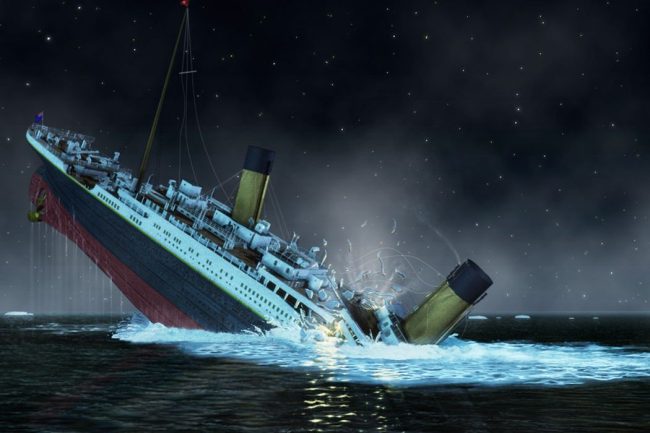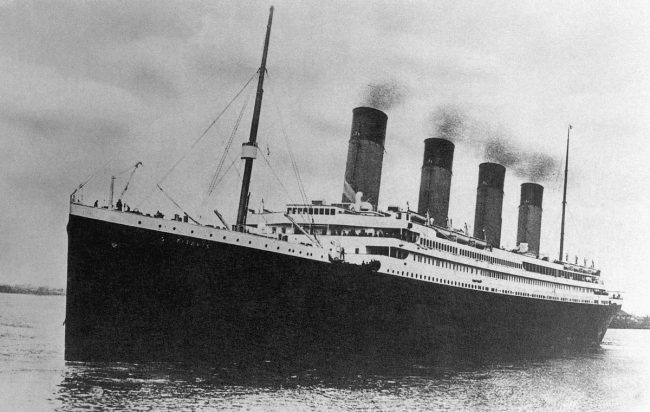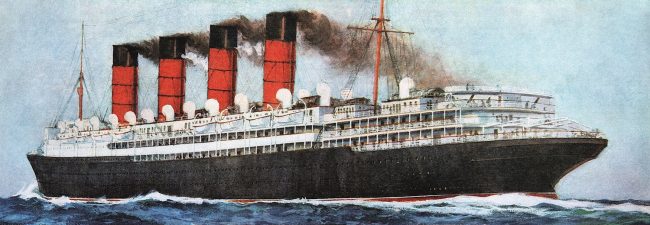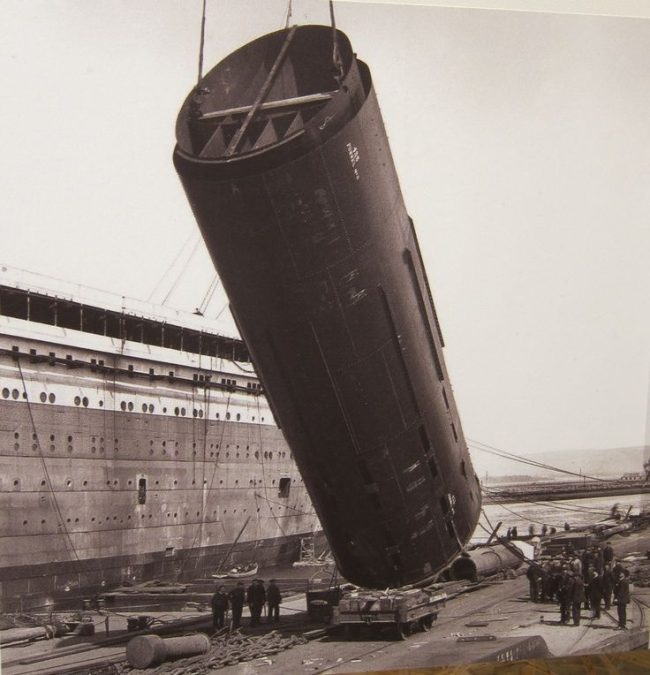15 Bone-Chilling Titanic Facts No One Knew
The RMS Titanic, an icon of human triumph and tragedy, has captivated the hearts and minds of millions since it met its fateful end on the night of April 14- April 15th, 1912. In this article, we will uncover bone-chilling Titanic facts that remain lesser-known, yet equally haunting.

15 Bone-Chilling Titanic Facts and Debunked Myths
This “unsinkable” vessel, once a symbol of pride and luxury, succumbed to the icy embrace of the North Atlantic Ocean after striking an iceberg on its maiden voyage. The sinking that claimed over 1,500 lives, has forever etched the Titanic’s story into our collective memory once James Cameron released his classic hit “Titanic”. I guess “our hearts will always go on” with the Titanic story. See what we did there? But let’s leave the romantic tale aside and delve into the depths of this legendary ship’s history. Join us as we journey through the mysteries, heroism, and chilling truths that surround the ill-fated Titanic. These are 15 bone-chilling Titanic facts that will leave you in awe.
1. People died on the Titanic even before its maiden voyage
Even before the Titanic embarked on its fateful journey, the specter of death loomed over its construction. Built over a gruelling 26-month period at the Harland and Wolff Shipyard in Belfast, the Titanic’s coming of age was marred by a series of accidents, almost foreshadowing the tragedy that would later unfold.
During the construction process, 28 serious accidents and 218 minor accidents happened. Despite the dangers of the time, only eight workers met their untimely demise, a smaller number than the expected one death for every £100,000 spent, which was associated with the working conditions of those times. Judging by the Titanic’s staggering £1.5 million price tag, the death toll for its construction could have gone up to 15 casualties.

The majority of these unfortunate souls perished from falls, either from the towering ship or the surrounding staging. On the day of the Titanic’s grand launch, a chilling incident occurred. As 10,000 onlookers held their breath, watching the colossal vessel slide onto the River Lagan, a 43-year-old shipwright named James Dobbin was crushed in the process. In a cruel twist of fate, he was killed while removing the timber stays that had kept the ship upright, setting the stage for the Titanic’s ill-fated voyage. If only poor Dobbin could have held the ship from embarking on its first and last tragic voyage.
2. More people could have survived
It’s such a crazy story. Originally, the ship was designed to have 64 lifeboats, but they ended up with just 20 because they didn’t want the deck to look cluttered. Talk about bad luck!
When the ship hit that iceberg and started sinking, there obviously weren’t enough lifeboats for everyone. The 20 lifeboats on board could fit about 1,178 passengers, which was just a small part of the over 2,200 people on the ship.
However, what’s even more troubling is that many of these lifeboats didn’t even get filled up all the way. Some of them had just a few passengers in them! For example, the first lifeboat, which could fit 65 people, was lowered into the water with only 28 people on it. What a mess!
There was so much confusion; the “unsinkable” had happened, and people didn’t even realize how serious things were. Plus, there weren’t enough crew members who knew how to handle the lifeboats properly. In the end, more than 1,500 people lost their lives because of these mistakes. It’s mind-blowing, isn’t it?
3. The Titanic was competing with other major ships at that time
You know, back in the early 1900s, things were really taking off with new technologies. So, the biggest British steamship companies started building these massive and super fancy ocean liners. Cunard, based in Liverpool, was the first to launch a couple of speedsters, the Mauretania in 1906 and the Lusitania in 1907. These bad boys could cross the Atlantic faster than anyone else!

Now, the White Star Line didn’t want to be left behind, so they decided to build their own trio of giants: the Olympic, Titanic, and Britannic. They were put together over in Belfast, Ireland (nowadays Northern Ireland), and let me tell you, they were designed to be the most luxurious ships ever.
So, picture this: you’re on the Titanic, which, by the way, is a “royal mail ship” (that’s what “RMS” stands for), and you’ve got all these amazing amenities like a swimming pool, tennis and squash courts, a gym, sunrooms, and super fancy dining rooms. They even added an extra hundred first-class cabins and a Parisian boulevard on B Deck to make it feel like you’re at a sidewalk café! And get this, the Titanic ended up being a whopping 1000 tons heavier than her sister ship, the Olympic. That’s a bone-chilling Titanic fact considering how it all went down in the end.
4. The largest movable man-made object of its time
First off, this gigantic ship measured an astonishing 269.1 meters (882 feet 9 inches) in length. That’s longer than two and a half football fields laid end-to-end! Now that’s a massive vessel. The members of the crew needed more than 2 weeks to learn their way around the ship. More exciting Titanic facts coming your way!
5. Bone-chilling Titanic Facts: The anchor itself was 15.5 tons
The Titanic’s main anchor was a massive piece of engineering, weighing in at an astounding 15.5 tons. To put that into perspective, that’s about the same weight as 10 small cars! So, as you can imagine, moving such a colossal anchor was no easy task. In fact, it required the combined strength of 20 strong and sturdy horses to haul it. Oh, you’ve got to love these exciting Titanic facts!
6. Bone-chilling Titanic Facts: The Titanic was a coal-eating monster
And get this, the Titanic was a coal-guzzling machine, burning through a whopping 825 tons of coal every single day. It’s hard to wrap our heads around how much energy it took to keep this colossal ship moving across the Atlantic.
But it wasn’t just the size and power that made the Titanic stand out. The attention to detail was just as impressive. Picture this: there were around 10,000 lamp bulbs used on the ship! That’s a whole lot of light, creating an atmosphere of luxury and sophistication throughout the entire vessel.
So, even by today’s standards, the Titanic was truly a marvel of engineering, design, and luxury. It’s no wonder that over a century later, we’re still talking about this legendary ship and its tragic, yet awe-inspiring story.
7. Get this! The Titanic needed only 3 smokestacks
As you have probably seen in the movie and pictures, the Titanic had these massive, 81.5-foot tall smokestacks that weighed a whopping 60 tons each. And they were placed at a menacing 30-degree angle from the deck – spewing out 100 tons of soot every single day! Now, here’s a fun little twist: even though there were four of them, only three actually did the job of venting smoke and fumes from the ship’s gigantic boilers.

The fourth smokestack was added to make the ship look even more majestic, powerful, and awe-inspiring. While it wasn’t used for the primary purpose of venting boiler smoke, it wasn’t just a pretty face. They got creative and used it to vent steam from the kitchens and provide ventilation to the crew quarters. So, it turns out that even though it was mainly there to make the Titanic look grand, the fourth smokestack still had some practical uses.
8. The wreck of the Titanic was somehow foretold
You know what’s pretty wild? There’s this novella called “The Wreck of the Titan: Or, Futility,” written by Morgan Robertson, and it’s got some seriously uncanny similarities to the real-life sinking of the RMS Titanic. First published as “Futility” in 1898, it was later revised and renamed in 1912.
The story revolves around this British ocean liner, the Titan, which sinks in the North Atlantic after hitting an iceberg – sounds familiar, right? People couldn’t believe the eerie connections between the fictional Titan and the actual Titanic, which sank 14 years later. In fact, after the Titanic disaster, the story was even reissued with a few tweaks, like changes to the ship’s gross tonnage.
Now, check this out: the novella was written before the Titanic was even a glimmer in anyone’s eye, but the similarities are hard to ignore. Both ships sank in April after colliding with an iceberg in the North Atlantic, and neither had enough lifeboats for all the passengers. The Titan, just like the Titanic, would’ve likely survived a head-on collision with the iceberg, but the glancing encounter caused catastrophic damage. There are even similarities in the ships’ size, speed, and life-saving equipment!
After the Titanic went down, some folks thought Robertson was psychic or clairvoyant, but he wasn’t having any of it. Instead, scholars believe that his spot-on descriptions came from his deep understanding of the industry, rather than any psychic or supernatural abilities.
9. 6 Million worth of belongings sank with the Titanic
Keep in mind that this figure is based on the value of those items at the time of the sinking in 1912. The value of those belongings would be much higher today, accounting for inflation and the historical significance of the artefacts.
You might find it fascinating that the Titanic’s first-class passengers had an estimated combined wealth of a whopping $500 million. John Jacob Astor IV, one of the wealthiest people of his time, contributed a massive $87 million to that amount. The irony is that Astor and his wife, Madeleine, had actually sailed on the Titanic’s sister ship, the Olympic, just months before boarding the doomed vessel. Sadly, Astor didn’t make it through the disaster, as the crew generally adhered to the “women and children first” principle.
There’s also an intriguing story about a man named Alfred Nourney. Masquerading as an aristocrat called Baron Alfred von Drachstedt, he used his fake identity to upgrade to first class. As the ship met its fate, Nourney managed to secure a place in a lifeboat quickly, unlike the 168 men from his original second-class quarters, where only 14 made it out alive.
It is also said that the Titanic survivors submitted insurance claims totalling almost $1.4 million for their lost property. The award for the largest single claim goes to Charlotte Cardeza, a first-class passenger. She stayed in one of Titanic’s “millionaire’s suites,” the most luxurious and expensive accommodations on the ship.
Get this – Charlotte was travelling with a staggering 14 trunks! Her claim, which spanned 21 pages, amounted to $177,352.75. The list of lost items was quite something, ranging from a humble bar of soap to an impressive collection of gloves, shoes and diamonds. Talk about travelling in style!
10. The Titanic sank because of a supermoon – myth debunked
So, you might’ve heard some folks claiming that a full moon was responsible for the sinking of the Titanic. While it’s a pretty interesting theory, it’s not really the whole story. The Titanic met its icy end mainly because it hit a massive iceberg. Speeding through the ocean, design flaws, and not enough lifeboats definitely didn’t help, either.
Now, about that full moon. Some researchers think that maybe, just maybe, the full moon played a tiny part in this tragedy. You see, back on January 4, 1912, we had a “supermoon.” The moon was super close to Earth, and it lined up with the sun and our planet. All these cosmic shenanigans could have led to extra-high tides, which might have sent more icebergs floating into the Titanic’s path.
It’s a cool idea, but we can’t just go around blaming the full moon for sinking the Titanic. There were a whole bunch of factors that led to the disaster, and pointing fingers at the moon just isn’t fair. So next time someone tries to blame the full moon for the Titanic’s sinking, just remember – it’s way more complicated than that! More bone-chilling Titanic facts coming your way!
11. Another bone-chilling Titanic fact: More than 1,000 bodies were never recovered
Most of the Titanic’s victims have been identified, but not all. Out of the approximately 1,500 people who died during the sinking, over 1,000 bodies were never recovered. The bodies that were found were primarily recovered by the ships that were sent to the area to search for bodies in the days following the disaster.
Some of the recovered bodies were identified through personal effects, clothing, and any documentation found on the victims. Some were buried at sea, while others were brought back to Halifax, Nova Scotia, for burial. Identification efforts were extensive, but not all of the recovered bodies could be identified.
In recent years, forensic science, genealogy, and DNA testing have been used to help identify some of the previously unidentified victims. Despite these efforts, there are still some unidentified victims, and the complete list of victims will likely never be fully known.
12. “Miss Unsinkable” was a lot more unsinkable than the Titanic
Let us tell you a story about this amazing lady named Violet Jessop. She was an ocean liner stewardess and nurse, and she’s super famous for surviving not just the Titanic, but two other major ship disasters as well. Talk about luck, right?

In 1911, she started working for the White Star Line, and she was on board the RMS Olympic when it had a collision with another ship. Nobody got hurt, but it was just the beginning of her incredible survival story. More bone-chilling Titanic facts coming.
In 1912, Violet boarded the Titanic as a stewardess. When the ship hit that iceberg and started to sink, she had to keep calm and reassure the passengers. Eventually, she ended up in Lifeboat 16, taking care of a baby throughout the night. Both she and the baby made it out alive.
But that’s not all! In 1916, Violet was on the HMHS Britannic, which was like the Titanic’s sister ship, when it hit a mine and sank during World War I. Violet escaped in a lifeboat and survived that disaster too.
People started calling her “Miss Unsinkable” because of her incredible luck. She kept working at sea until she retired and passed away in 1971 at the age of 83. Isn’t her story just mind-blowing?
13. Swimming was never an option
So, when the Titanic sank, most of the lucky survivors were the ones who got onto the lifeboats before everything went downhill. Sadly, not many people were actually saved from the icy waters after the ship disappeared beneath the waves. The water was super cold, like 28°F (-2°C) cold, which meant folks couldn’t last more than a few minutes before hypothermia set in. That’s some literal bone-chilling Titanic facts.
You see, the people on the lifeboats that had already taken off were pretty scared to head back and pick up people in the water. They were worried that desperate swimmers would try to climb in and end up flipping the boats, which would be bad news for everyone. But there was one brave lifeboat, Lifeboat 14, led by Fifth Officer Harold Lowe. He decided to go back after waiting for things to calm down a bit.
Lifeboat 14 managed to rescue a few people from the water, but by the time they got there, a lot of them had already been taken by the cold. In the end, only a handful of people were saved from the freezing water, and not all of them made it. Most of the survivors were those who were lucky enough to find a spot on a lifeboat.
14. The Titanic was originally a mail ship
Yes, the Titanic was indeed responsible for delivering mail for the British Postal Service. It was designated as a Royal Mail Ship (RMS), a title granted to British merchant ships that carried mail under contract with the British postal service. Those are some unfashionable Titanic facts.
The Titanic was carrying more than 3,000 sacks of mail, which contained millions of individual pieces of mail, including letters, postcards, and parcels. The mail was intended for delivery to various destinations, including the United States and Canada. Unfortunately, when the Titanic sank on April 15, 1912, most of the mail was lost with the ship.
15. You can visit the Titanic wreck yourself
A team of explorers discovered the Titanic wreck in 1985. The ship was resting deep in the North Atlantic, about 370 miles off the coast of Newfoundland, Canada, at a depth of 12,500 feet.
Now, here’s where it gets really interesting. The wreck is scattered over a 2-square-mile area, with the bow and stern almost 2,000 feet apart. And let me tell you, the remains of the Titanic are a sight to behold, even though they’ve been slowly deteriorating due to corrosion, underwater critters, and ocean currents.
People have been fascinated by the Titanic wreck ever since it was discovered, and it has sparked quite a few debates about how to preserve the site and the ethics of taking artefacts from it.
Now, you might be wondering if you can visit the wreck yourself. Well, it’s not easy or cheap, but there were a few commercial companies over the years offering trips to see it up close in a special submersible. So, if you’re feeling adventurous and have some spare cash, it could be the experience of a lifetime.
